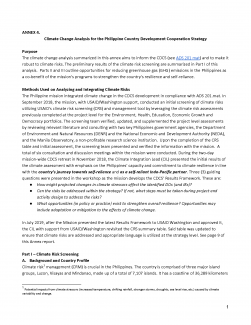Purpose
The climate change analysis summarized in this annex aims to inform the CDCS (see ADS 201 mat) and to make it robust to climate risks. The preliminary results of the climate risk screening are summarized in Part I of this analysis. Parts II and III outline opportunities for reducing greenhouse gas (GHG) emissions in the Philippines as a co‐benefit of the mission’s programs to strengthen the country’s resilience and self‐reliance.
Methods Used on Analyzing and Integrating Climate Risks
The Philippine mission integrated climate change in the CDCS development in compliance with ADS 201.mat. In September 2018, the mission, with USAID/Washington support, conducted an initial screening of climate risks utilizing USAID’s climate risk screening (CRS) and management tool by leveraging the climate risk assessments previously completed at the project level for the Environment, Health, Education, Economic Growth and Democracy portfolios. The screening team verified, updated, and supplemented the project level assessments by reviewing relevant literature and consulting with two key Philippines government agencies, the Department of Environment and Natural Resources (DENR) and the National Economic and Development Authority (NEDA), and the Manila Observatory, a non‐profitable research science institution. Upon the completion of the CRS table and initial assessment, the screening team presented and verified the information with the mission. A total of six consultation and discussion meetings within the mission were conducted. During the two‐day mission‐wide CDCS retreat in November 2018, the Climate Integration Lead (CIL) presented the initial results of the climate assessment with emphasis on the Philippines’ capacity and commitment to climate resilience in line with the country’s journey towards self‐reliance and as a self‐reliant Indo‐Pacific partner. Three (3) guiding questions were presented in the workshop as the mission develops the CDCS’ Results Framework. These are:
- How might projected changes in climate stressors affect the identified DOs (and IRs)?
- Can the risks be addressed within the strategy? If not, what steps must be taken during project and activity design to address the risks?
- What opportunities (in policy or practice) exist to strengthen overall resilience? Opportunities may include adaptation or mitigation to the effects of climate change.
In July 2019, after the Mission presented the latest Results Framework to USAID Washington and approved it, the CIL with support from USAID/Washington revisited the CRS summary table. Said table was updated to ensure that climate risks are addressed and appropriate language is utilized at the strategy level. See page 9 of this Annex report

